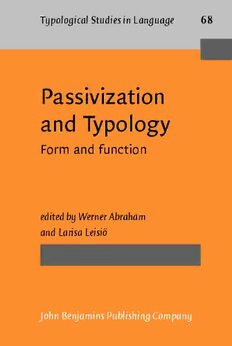
Passivization and Typology: Form and Function PDF
567 Pages·2006·3.425 MB·Typological Studies in Language 68
Most books are stored in the elastic cloud where traffic is expensive. For this reason, we have a limit on daily download.
Preview Passivization and Typology: Form and Function
Description:
Is the passive a unified universal phenomenon? The claim derived from this volume is that the passive, if not universal, has become unified according to function. Language as a means of communication needs the passive, or passive-like constructions, and sooner or later develops them based on other voices (impersonal active, middle, reflexive), specific semantic meanings such as adversativity, or tense-aspect categories (stative,perfect, preterit). Certain contributors review the passives in various languages and language groups, including languages rarely discussed. Another group of contributors takes a novel theoretical approach toward passivization within a broad typological perspective. Among the languages discussed are Vedic, Irish, Mandarin Chinese, Thai, Lithuanian, Mordvin, and Nganasan, next to almost all European languages. Various theoretical frameworks such as Optimality Theory, Modern Structuralist Approaches, Role and Reference Grammar, Cognitive Semantics, Distributed Morphology, and Case Grammar have been applied by the different authors.
See more
The list of books you might like
Most books are stored in the elastic cloud where traffic is expensive. For this reason, we have a limit on daily download.
